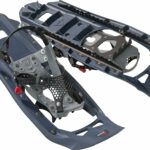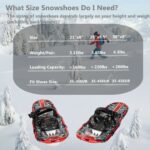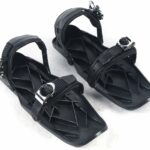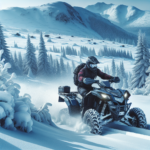Embarking on a winter adventure soon but confused about the right footwear? You’re probably wondering if your trusty snow boots can fit snugly into snowshoes without causing discomfort or compromising performance on the snowy trail. This article is going to clear up that confusion for you. “Can You Wear Snow Boots With Snowshoes?” seeks to provide definitive answers about the suitability and effectiveness of pairing your snow boots with snowshoes. With this information at your disposal, you’ll make efficient and practical gear decisions in no time.
Understanding the Purpose of Snowshoes
Snowshoes serve an essential function in facilitating outdoor winter activities. They work by distributing your weight over an expansive surface area, reducing your overall foot pressure as you tread on snow.
Importance of Snowshoes in Winter Activities
They are a fundamental asset for traversing over snowy landscapes effectively without the fear of sinking. Slippery ice-covered terrains become accessible due to the firm grip that they provide. Snowshoeing allows for peaceful exploration of the serene winter landscapes, and it also offers a great aerobic exercise option during the cold months.
The Design and Functioning of Snowshoes
Snowshoes are designed with a wide frame to distribute your weight evenly across a larger surface area. They have bindings attached to the frame that keep your shoes firmly in place. The snowshoes’ underside also contains crampons or spikes that provide the necessary grip and prevent you from slipping on icy surfaces.
Types of Footwear Compatible with Snowshoes
Your footwear choice for snowshoeing is just as critical as the snowshoes themselves. The right type of boots can remarkably improve your snowshoeing experience.
Features of Suitable Footwear for Snowshoes
Boots compatible with snowshoes should ideally be waterproof and insulated to keep your feet warm and dry. They should also be high enough to prevent snow from entering the boots.
Different Styles and Types of Compatible Boots
Various types of boots, ranging from insulated winter boots, hiking boots to mountaineering boots, could work with snowshoes. The suitability depends on factors like the nature and duration of activity, the weather, and personal comfort.
In-depth on Snow Boots
Snow boots are typically the preferred choice for snowshoeing due to their enhanced features designed specifically for cold and wet conditions.
Understanding Snow Boots
Snow boots are designed to provide maximum insulation for your feet in extremely cold environments. They typically have a rubber sole and lower half to make them waterproof, with the upper part made of leather or synthetic materials.
Different Types and Designs of Snow Boots
Snow boots come in various designs, each catering to distinct needs. While some are focused on providing maximum warmth, others prioritize water resistance or comfort. Be it the traditional pac boots, over-the-ankle boots, or heavy-duty boots; there’s a type for every requirement.
Snow Boots and Snowshoes: The Compatibility
Pairing snow boots with snowshoes can lead to a harmonious combination, enhancing your winter adventures.
Why Snow Boots are Ideal for Snowshoes
As snow boots are designed for harsh winter conditions, they usually have a snug fit, high insulation, and water-resistance, which makes them ideal for snowshoeing. These features will ensure that you always remain comfortably warm and dry, even in frigid, snowy conditions.
Instances Where Snow Boots Might be Unsuitable
However, there may be instances where wearing snow boots with snowshoes may not be suitable. If you’re engaging in highly physically strenuous activities, insulated snow boots might cause your feet to sweat excessively. Also, for long-distance hiking, the weight of snow boots may become a hindrance.
Considering Comfort and Fit
Comfort and fit play an essential role in ensuring an enjoyable snowshoeing experience. The right size and good fit can prevent discomfort and possible injuries.
How to Select the Right Snow Boot Size for Snowshoes
Picking the size for your boots can be tricky due to various manufacturers and styles. Always make sure to try on the boots with the same kind of socks you plan to wear while snowshoeing. There should be enough room to wiggle your toes, but the boots shouldn’t be loose enough to allow your feet to slide or lift within them.
Importance of Comfort and Fit in Snow Activities
Maintaining comfort and a good fit is crucial for prolonged snow activities. Boots that are too large or too small can cause discomfort, blisters, and even long-term foot problems. A comfortable, well-fitting boot ensures that you can focus on the trail ahead without being distracted by foot discomfort.
Importance of Insulation and Warmth
The most significant factor to consider in snow activities is insulation.
Role of Insulation in Snow Boots
Insulation in snow boots helps to retain heat around your feet. This stops them from freezing in negative temperatures.
Why Warmth is Crucial in Snow Activities
Keeping your feet warm not only ensures comfort but also prevents frostbite and other cold-related complications, especially during prolonged snow activities.
Analyzing Traction and Stability
Staying balanced on snowy and icy surfaces can be a major challenge.
Importance of Traction in Snow Boots and Snowshoes
Traction is paramount in snowy conditions to prevent slips and falls. The soles of the boots should have deep lugs and should be made of rubber that stays flexible in cold conditions.
Ensuring Stability when Using Snowshoes
Snowshoes provide additional stability by increasing your point of contact with the snowy surface. Good traction and stability are fundamental to have an enjoyable and safe snowshoeing experience.
Water Resistance and Protection
Keeping your feet dry is incredibly crucial when venturing out into the snow.
Need for Water Resistance in Snow Boots
Water-resistant boots prevent snow and water from penetrating the boots. The boots should not only stop the water from entering but also allow the moisture from inside to escape.
Effect of Wet Feet on Performance and Health
Wet feet can not only cause discomfort and blisters but can also lead to hypothermia in extreme conditions, seriously harming your performance and health.
Maintenance of Snow Boots and Snowshoes
Proper care and maintenance can significantly enhance the life of your snow boots and snowshoes.
How to Clean and Store Snow Boots and Snowshoes
You should always clean off the dirt and salt after each use. Let them dry completely before storing in a cool and dry place. Do not expose them to excessive heat as it can ruin the material.
Periodic Maintenance Required for Longevity
Periodically conditioning boots with a suitable product can protect the material, and inspecting the crampons on your snowshoes for wear and tear can prevent surprises on the trails.
Essential Tips for Using Snow Boots with Snowshoes
Learning how to best use snow boots with snowshoes can give you the best experience.
Tips for Beginner Snowshoers
Start off with shorter trails and gradually go for longer ones. Avoid wearing new boots on an extended expedition; it takes time for your feet to adapt to new footwear. Always have a pair of gaiters on standby.
Safety Precautions to Take While Snowshoeing
To ensure your safety, always check the weather conditions before you start. Inform someone about your plan and expected return time. Having basic first aid supplies along can also be useful.
To sum it up, wearing snow boots with snowshoes offers a world of comfort, warmth and protection that is simply unmatched. By choosing the right boots and properly pairing them with your snowshoes, you can get the most out of your winter exploration. Happy snowshoeing!
- What Snowboard Bindings Should I Get? - January 23, 2024
- What Size Screws For Snowboard Bindings? - January 23, 2024
- How To Snowmobile On Water? - January 23, 2024










